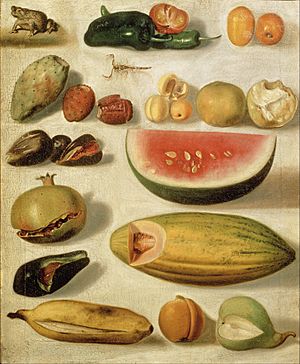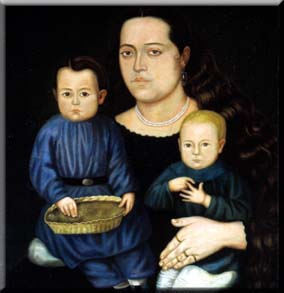Hermenegildo Bustos facts for kids
José Hermenegildo de la Luz Bustos Hernández (born April 13, 1832, in Purísima del Rincón – died June 28, 1907, in Purísima del Rincón) was a famous Mexican painter. He was best known for painting portraits of people. He also created religious paintings and pictures of everyday objects, called still-lifes.
Contents
A Look at Hermenegildo Bustos' Life
Hermenegildo Bustos grew up in a small village in a very religious Catholic family. His family had Indigenous roots. Even though he lived in a quiet place, his youth was a time of big changes in Mexico. There was a serious sickness called cholera and important land reforms. Mexico was also becoming its own nation.
Like his father, Hermenegildo worked as a village record-keeper. He wrote down names, dates, and important events. He was also very skilled with his hands. At different times, he worked as a tinsmith, tailor, carpenter, musician, and even a builder (mason). He loved history and learning about stars (astronomy). He also took care of an orchard for most of his life.
His Artistic Journey and Training
Hermenegildo Bustos did not have much formal art training. He spent only six months with Juan Nepomuceno Herrera, a portrait painter from a nearby city called León. It seems he didn't learn a lot from this experience.
His first known painting was in 1850 when he was 18 years old. It was a portrait of a local priest named Vicente Arriaga. In 1852, he painted a portrait of his father, who had passed away the year before. This is called a "posthumous portrait" because it was painted after his father's death.
Over the next few years, Hermenegildo painted many portraits of important families in his area. He got married in 1854. For two weeks in 1858, the future President of Mexico, Benito Juárez, stayed in Purísima. Bustos was chosen to paint his portrait, but this painting is now lost.
His Famous Self-Portrait and Legacy
Hermenegildo Bustos painted his own self-portrait much later, in 1901. For this painting, he designed and made his own coat. On the coat, he wrote in Spanish: Hermenegildo Bustos, indio de este pueblo de Purísima del Rincón, nací el 13 de abril de 1832. This means: "Hermenegildo Bustos, Indigenous person of this town of Purísima del Rincón, I was born on April 13, 1832."
He often wrote on the back of his paintings: Hermenegildo Bustos de aficionado pintó. This means "Hermenegildo Bustos, painted by an amateur." This shows his humble nature, even though he was a very talented artist. Some sculptures in his village are also believed to be made by him, including religious figures like Ecce Homo and Virgen de los Dolores.
After the Mexican Revolution, people started to appreciate Mexico's cultural history more. Bustos's artwork gained more attention. He became well-known after being featured in a book called Pintura Mexicana by Roberto Montenegro. In 1940, his work was shown in a big art exhibition in New York City at the Museum of Modern Art. His paintings were also displayed in Paris (1952), London (1953), and Tokyo (1955).
In 1956, part of his hometown was renamed "Purísima de Bustos" to honor him. The famous Mexican writer Octavio Paz also wrote about Hermenegildo Bustos in 1985, showing how important his art was.
Hermenegildo Bustos' Artworks
Hermenegildo Bustos is celebrated for his unique style. His portraits capture the personalities of the people he painted. His still-lifes often show everyday objects with great detail and realism.
See also
 In Spanish: Hermenegildo Bustos para niños
In Spanish: Hermenegildo Bustos para niños













